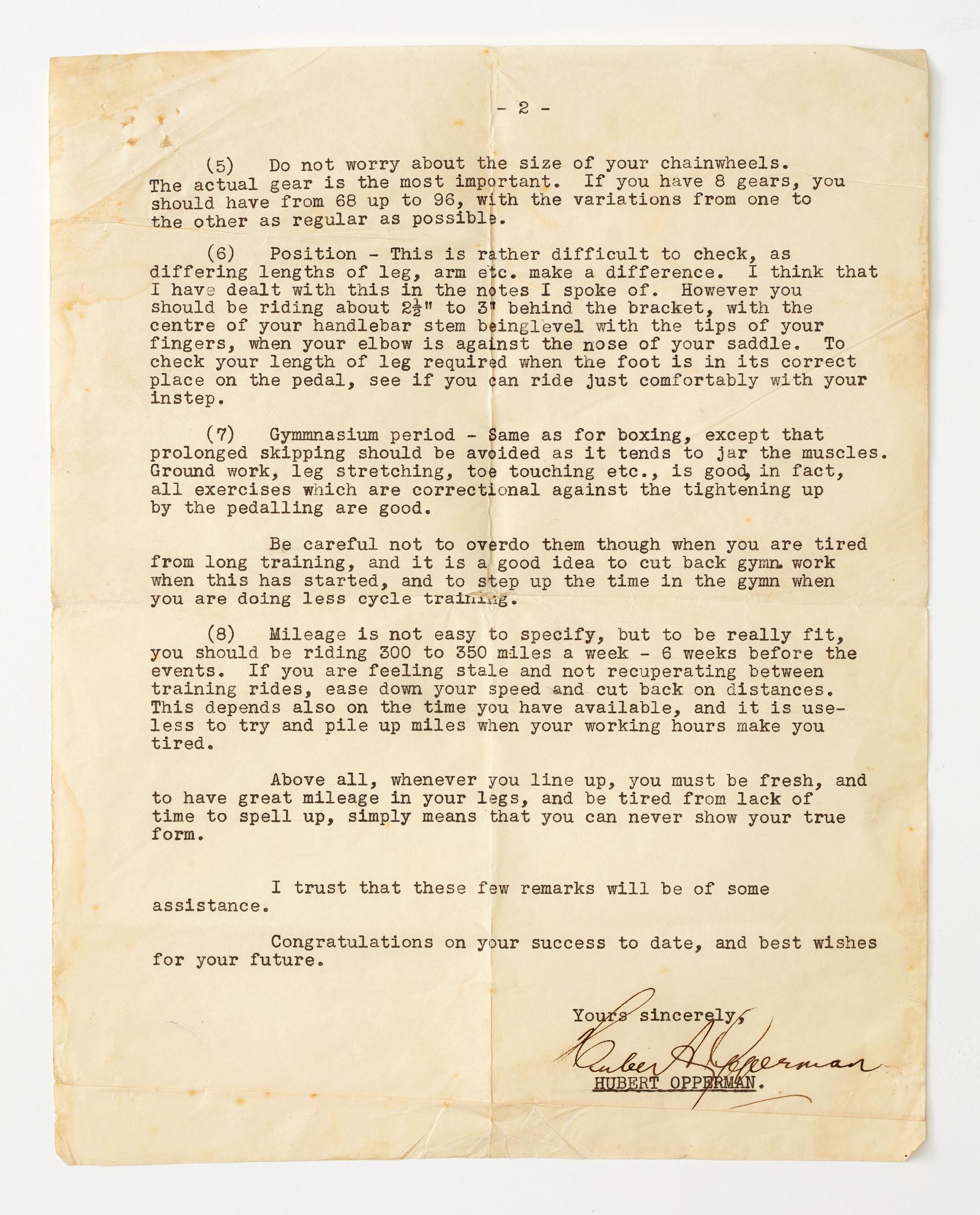A Letter From Oppy
Thomas Massam, was an active amateur racer in WA in the 50’s. In 1952 he received the below letter from Hubert Opperman in response to a request for training ad- vice. Thomas recently made a generous donation of the letter to the club along with his state jersey, his amateur certi ca- tion and some photographs.
25th February 1952
Dear Mr. Massam,
Acknowledgement is made of your letter of the 6th January, and I must apologise for not replying at an earlier date. However I have been away Interstate and at Canberra, and this is the rst opportunity I have had to reply.
Actually I cannot hope to go into any great detail, but if I can nd some training hints which I wrote some years back I will have them forwarded to you.
(1) Diet is a subject of its own, if you decide to special- ize. I followed one known as the “Dr. Hay” diet, but that only came after years of experience. Meantime keep to grills, avoid fried foods and pastries, eat plenty of fruit and do not eat heavily within 11⁄2 hours of a race.
(2) In a race, eat small quantities and often. Do not drink unless thirsty, and then only a mouthful at a time.
(3) I couldn’t possibly tell you how to massage - books by specialists are written on this subject, and masseurs take special courses at the Universities. However the object of massage is to tone up tired muscles and cre- ate a feeling that you are better for this. If your muscles are sore afterwards as a result of the massage or you do not feel any better for it, then you should change your masseur. After road training, you need at least an half hour “rub down” at least three times a week.
(4) Australians use 61⁄2” cranks only because they hap- pen to always be B.S.A. standard length. Continental cranks used by the worlds’ greatest are invarabiy the equivelant of 63⁄4”or 7”. I would say that with your size, you would be justi ed in using 63⁄4” at least or 7” but 63⁄4” would be the safest. Only do not mess around once you have decided.
(5) Do not worry about the size of your chainwheels. The actual gear is the most important. If you have 8 gears, you should have from 68 up to 96” with the vari- ations from one to the other as regular as possible.
(6) Position - This is rather dif cult to check, as differing lengths of leg, arm etc. make a differences I think that
I have dealt with this in the notes I spoke of. However you should be riding about 21⁄2” to 31 behind the brack- et, with the centre of your handlebar stem being level with the tips of your ngers, when your elbow is against the nose of your saddle. To check your length of leg re- quired when the foot is in its correct place on the pedal, see if you can ride just comfortably with your instep.
(7) Gymmnasium period - Same as for boxing, except that prolonged skipping should be avoided as it tends to jar the muscles. Ground work, leg stretching, toe touching etc., is good, in fact, all exercises which are correctional against the tightening up by the pedalling are good.
Be careful not to overdo them though when you are tired from long training, and it is a good idea to cut back gymn work you when are this has started, and to step up the time in the gym when you are doing less cycle training.
(8) Mileage is not easy to specify but to be really t, you should be riding 300 - 350 miles a week - 6 weeks before the events. If you are feeling stale and not recu- perating between training rides, ease down your speed and cut back on distances. This depends also on the time you have available, and it is useless to try and pile up miles when your working hours make you tired.
Above all, whenever you line up, you must be fresh, and to have great mileage in your legs, and be (not) tired from lack of form, time to spell up, simply means that you can never show your true form.
I trust that these few remarks will be of some assistance.
Congratulations on your success to date, and best wishes for your future.
Yours sincerely
Hubert Opperman


